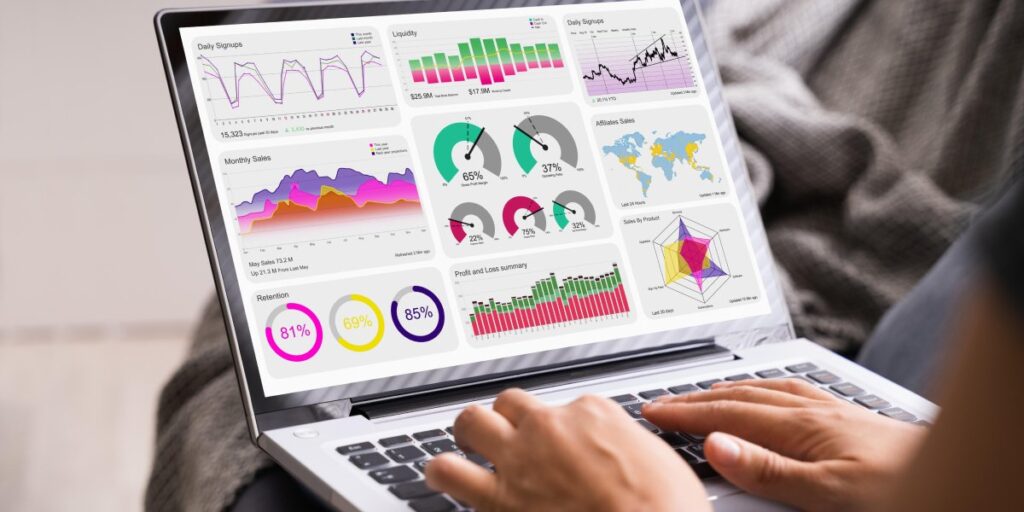In today’s data-driven world, marketing analytics tools have become indispensable for businesses aiming to make informed decisions, track performance, and optimize their marketing strategies. These tools help marketers collect and analyze data across various digital channels, providing valuable insights that can be used to improve campaigns, increase ROI, and better understand customer behavior. This article explores some of the most effective marketing analytics tools available today, and how businesses can leverage them to enhance their marketing efforts and achieve measurable results.
Google Analytics
Google Analytics is one of the most widely used and versatile marketing analytics tools available. It provides businesses with in-depth insights into website traffic, user behavior, and conversions. With Google Analytics, marketers can track how users arrive at their website, what pages they visit, how long they stay, and whether they take desired actions, such as making a purchase or filling out a contact form. This tool allows for detailed segmentation of audiences based on various factors like location, demographics, and device usage, helping businesses understand their visitors better. Furthermore, it integrates seamlessly with other Google products like Google Ads, enabling marketers to measure the performance of paid campaigns alongside organic traffic. With its robust reporting features, Google Analytics is an essential tool for businesses looking to optimize their online presence.
HubSpot Analytics
HubSpot is a comprehensive marketing platform that offers powerful analytics features to help businesses manage inbound marketing campaigns. It provides detailed reports on website performance, lead generation, email campaigns, social media engagement, and more. HubSpot’s analytics tools offer a centralized dashboard where marketers can view and analyze key metrics across different marketing channels in one place. One of HubSpot’s most notable features is its ability to track leads through the entire customer journey, from the first touchpoint to final conversion. This feature allows businesses to assess which marketing efforts are most effective in driving revenue and customer retention. Additionally, HubSpot provides tools for A/B testing, helping businesses refine their campaigns and improve their results over time.
SEMrush
SEMrush is a popular all-in-one digital marketing tool that is particularly effective for SEO and competitive analysis. It provides marketers with detailed insights into their website’s SEO performance, including keyword rankings, backlink profiles, and site audits. SEMrush also offers tools for competitor analysis, enabling businesses to track the performance of competitors’ websites, keywords, and digital advertising strategies. By analyzing this data, businesses can identify opportunities for improvement and develop more effective strategies. SEMrush’s paid search analytics help businesses optimize their PPC campaigns, ensuring that they are targeting the right keywords and maximizing their ad spend. This tool is invaluable for businesses looking to improve their SEO and paid search efforts while gaining a competitive edge in their industry.
Kissmetrics
Kissmetrics is a powerful analytics tool designed to provide in-depth insights into customer behavior across digital touchpoints. Unlike traditional analytics platforms, Kissmetrics focuses on tracking individual customer journeys rather than just website traffic. It helps businesses understand how users interact with their website, product, or service, and which actions lead to conversions. Kissmetrics is particularly useful for businesses with subscription models or long sales cycles, as it allows for detailed tracking of customer retention, lifetime value, and engagement. The tool also offers cohort analysis, which helps businesses segment customers based on shared behaviors and monitor how different groups perform over time. With its focus on customer behavior and retention, Kissmetrics is a valuable resource for businesses looking to optimize their customer lifecycle and improve long-term engagement.
Social Media Analytics Tools

Social media analytics tools are essential for businesses looking to measure the performance of their social media campaigns. Platforms like Facebook, Instagram, Twitter, and LinkedIn all offer built-in analytics tools, but businesses can also use third-party tools for more comprehensive insights. Tools like Sprout Social, Hootsuite, and Buffer provide in-depth analytics on engagement, reach, clicks, and audience demographics across multiple social media platforms. These tools allow marketers to track the effectiveness of their social media strategies, monitor brand sentiment, and identify trends that can inform future campaigns. Additionally, they often include features for scheduling posts, responding to customer inquiries, and managing social media communities, making them essential for businesses seeking to optimize their social media marketing efforts.
Adobe Analytics
Adobe Analytics is an advanced marketing analytics tool that provides businesses with detailed insights into customer behavior and digital marketing performance. It is particularly suited for large enterprises and businesses with complex marketing needs. Adobe Analytics offers powerful features for analyzing website traffic, customer segments, and conversion paths. It also integrates with other Adobe Marketing Cloud products, allowing for a seamless flow of data across different marketing channels. One of Adobe Analytics’ standout features is its ability to provide predictive insights using artificial intelligence, helping businesses forecast future trends and optimize campaigns in real time. The tool’s advanced segmentation and reporting capabilities make it an excellent choice for businesses looking to gain a deeper understanding of their customers and improve their marketing strategies.
Crazy Egg
Crazy Egg is a user behavior analytics tool that specializes in providing visual insights into how users interact with your website. Its heatmaps, scroll maps, and click maps allow businesses to see exactly where visitors are clicking, how far they are scrolling, and what parts of the website are getting the most attention. This type of data is invaluable for improving user experience (UX) and optimizing website design. Crazy Egg also offers A/B testing capabilities, allowing businesses to test different variations of their website to determine which elements lead to higher conversions. By understanding user behavior in such detail, businesses can make data-driven decisions about how to adjust their website’s layout and content to drive better results.
Hotjar
Hotjar is another popular user behavior analytics tool that helps businesses understand how visitors interact with their website. Like Crazy Egg, Hotjar provides heatmaps and session recordings that show where users click, how they navigate pages, and where they abandon their sessions. In addition to these features, Hotjar offers tools for collecting user feedback through surveys and polls, giving businesses direct insights into what their visitors think about their website. Hotjar’s “funnels” feature allows businesses to track where visitors drop off during the conversion process, helping identify obstacles that may be preventing users from completing their desired actions. With its combination of user behavior tracking and feedback collection, Hotjar is an essential tool for improving website usability and conversion rates.
Microsoft Power BI
Microsoft Power BI is a business analytics tool that enables companies to visualize and share insights from their data. Although it is not a marketing tool by default, Power BI can be integrated with various marketing platforms to create custom reports and dashboards that provide valuable insights into marketing performance. Power BI allows marketers to analyze data from multiple sources, including social media platforms, email campaigns, website traffic, and sales data. Its drag-and-drop interface makes it easy to create visually appealing reports, while its powerful data analysis capabilities allow for deep dives into marketing trends and performance metrics. Power BI is particularly useful for businesses that want to combine marketing data with other business intelligence to drive more informed decisions and optimize their marketing strategies.
Mixpanel
Mixpanel is an advanced analytics tool that focuses on tracking and analyzing user behavior in real time. It is particularly useful for businesses with mobile apps or SaaS (Software as a Service) platforms, as it allows them to track how users interact with specific features within an app or software. Mixpanel provides detailed event tracking, allowing businesses to see exactly what actions users are taking within their product. Additionally, it offers funnel analysis, cohort analysis, and A/B testing, helping businesses understand how different segments of users behave and which actions lead to conversions. Mixpanel’s real-time data helps businesses make quick decisions and optimize their user experiences on the fly, making it an essential tool for product-based businesses.
Conclusion
Marketing analytics tools play a pivotal role in helping businesses make informed decisions, optimize their marketing strategies, and measure the effectiveness of their campaigns. Whether it’s tracking website performance, analyzing social media engagement, or understanding customer behavior, the right analytics tools provide valuable insights that can drive better results and enhance ROI. By using tools like Google Analytics, HubSpot, SEMrush, Kissmetrics, and others, businesses can gain a deeper understanding of their audience, improve their marketing tactics, and stay ahead of the competition. In the fast-paced digital marketing landscape, investing in the right analytics tools is key to long-term success and growth.
















